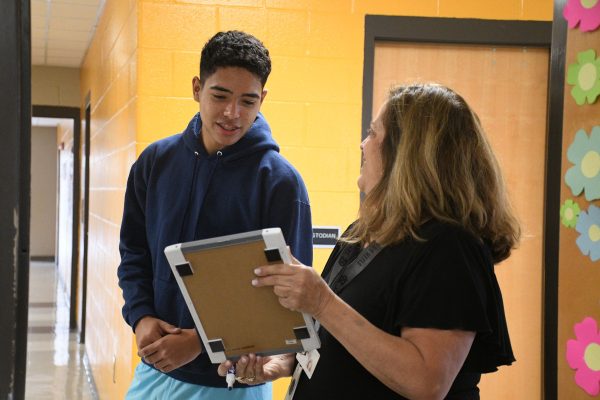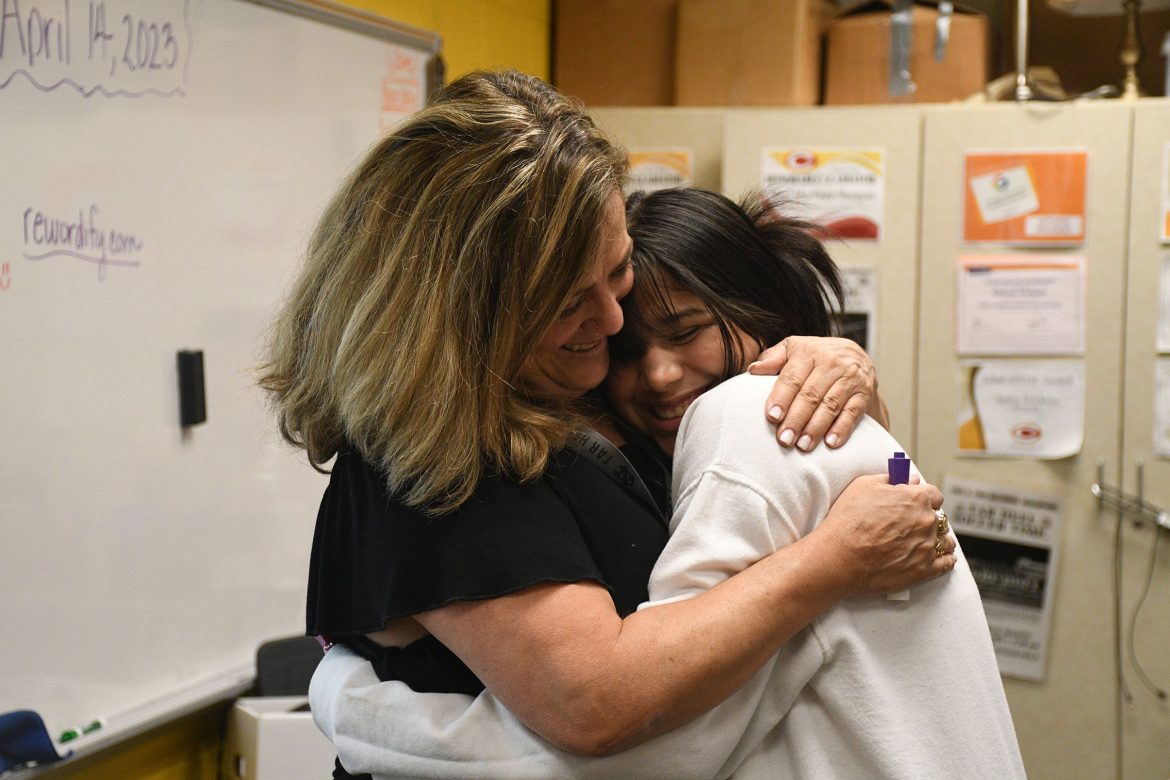Clarke Central High School English for Speakers of Other Languages (ESOL) social studies department teacher Kathy Erickson hugs CCHS junior and ESOL student Ashlee Gamboa in Room 374 on April 14. Erickson expressed support for small group learning where students were able to receive much more individualized attention and support. “It really does behoove the students to be able to come to a small group area, like my room right here. They can come and get the instruction from me, and it helps them because they’re gonna tend to be more open to ask questions,” Erickson said. “It’s hard enough to get anybody to participate, let alone our ESOL students, who are a little bit more quiet, more reserved (and) fighting the barrier
CCHS’ English for Speakers of Other Languages program prepares students or life in and outside of the classroom, overcoming organizational constraints and keeping up with rapidly increasing U.S. immigration.
Clarke Central High School senior Raul Navarro has been in the United States for three months. In three months, he’s had to adjust to an almost entirely new environment compared to his former home country of Venezuela. In three months, he’s had to learn English to participate in his classes at CCHS. In three months, he’s become almost entirely dependent on the school’s English for Speakers of Other Languages (ESOL) resources and community English services.
He’s not alone. Navarro is one of more than 100,000 Georgia students currently participating in the ESOL program. The state has provided English language services since 1974, supporting international newcomer English Learners (ELs) and American students with little-to-no English skills, integrating students into English-only classes and assisting newcomer parents.
More broadly, Georgia is home to one of the largest immigrant populations in the country, according to the Migration Policy Institute, with this number growing consistently throughout the past 40 years. This increase in immigration, especially from Latin America, has grown the ESOL program significantly.

Featured: WORKING TOGETHER: Clarke Central High School English for Speakers of Other Languages (ESOL) freshmen Jan Hernandez and Edrian Vanegas work on an assignment in Room 387 on April 14. ESOL math department teacher Cori Pringle felt the ESOL program will continue the growth she has seen since she began teaching at CCHS. “When I first started with two and a half of us (teachers), we just had to be so spread out. (For example), we didn’t get to serve seniors at all because we just didn’t have enough of us to make it into (those) classes,” Pringle said. “Now, all of the core classes are covered with one of us in there to support the kids, so that’s been a huge improvement. (ESOL is) going to (keep getting) better and better.” Photo by Isabelle Duncan
“We’ve had a lot more students coming in from other countries as newcomers, meaning that they did not speak English before they got here, so our program has really diversified,” CCHS ESOL math department teacher Cori Pringle said. “Before, (we were) mostly helping students who were born here but spoke different languages at home and then had to acclimate to English language or American culture. Now, it’s more supporting their language and helping them not just be able to talk and communicate, but understand in the academic sense, so it’s been a big shift.”
The program hasn’t been without its flaws, however. CCHS ESOL science department teacher Terence Martin believes that oftentimes, curriculums can be vague or not reflect the content guidelines of the base classes.
“I would like having more set curriculum so that we really knew exactly what they needed to know, and what was going to be expected of them,” Martin said. “(We) could concentrate more on just language.
According to Pringle, coordination between teachers throughout CCHS’ ESOL program is made more difficult due to the small team having to cover the needs of the whole school, sometimes leaving department-wide planning behind.
“I co-teach with (CCHS math department co-chair Heather) Julian and we’re together all day. We plan together and (can) really support our kids,” Pringle said. “That’s (also) where our weakness is. (When) we don’t get to plan with the team that we’re teaching (with), we miss a lot of things (and) places where we can support our students.”
Despite this, ESOL has only grown since its inception during the ‘80s, and expanded to provide services to the parents of English Learner (EL) students.
For ESOL English department teacher Carrie Emerson, engaging with parents and the broader community outside of school-served ESOL students has been a priority during her tenure at CCHS.
“A big thing for me is family engagement. I knew when I moved back to Athens and started this job, I really wanted to start doing adult classes again, (which are) funded through money from the district,” Emerson said. “I think it’s extra important to try and engage the English Learner parents because there can be a lot of barriers for them to communicate with the school or to feel comfortable coming to the school.”
“I think it’s extra important to try and engage the English Learner parents because there can be a lot of barriers for them to communicate with the school or to feel comfortable coming to the school.”
— Carrie Emerson,
ESOL English department teacher
With three months under his belt at CCHS, Navarro feels the ESOL program has helped him learn English and become accustomed to his new home.
“I think (the ESOL program) is good. (They) help you every time. If you don’t understand in English, they explain in Spanish, (which) help you learn English,” Navarro said. “I don’t have class with (Ms. Erickson), but she’s a good person. She helped me (with) hard words or something that I don’t understand in my class. She helped me to do that.”
Pringle believes the ESOL program will only continue expanding to meet the needs of more students, and is hopeful for the future of English language services at CCHS.
“We’re just going to continue growing. When I first started with two and a half of us (teachers), we just had to be so spread out. (For example), we didn’t get to serve seniors at all because we just didn’t have enough of us to make it into (those) classes,” Pringle said. “Now, all of the core classes are covered with one of us in there to support the kids, so that’s been a huge improvement. (ESOL is) going to (keep getting) better and better.”
